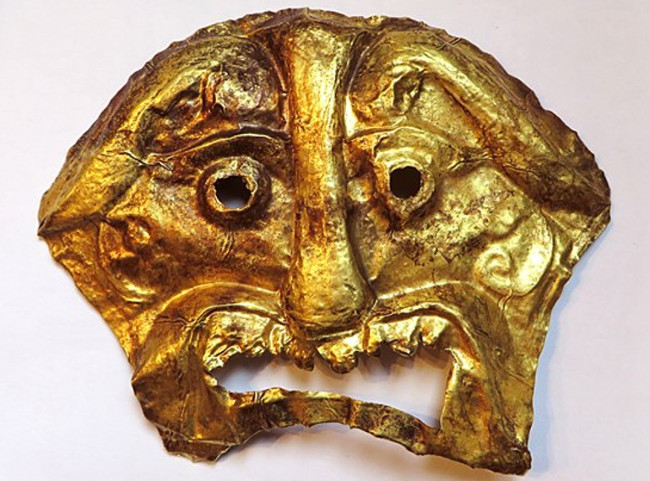The mystery of the Tuong Hung in Tibet
Centuries ago, in the Iron Age, on the high mountains of western Tibet, the Zhangzhung built a civilization complete with rich technical and artistic advances , with beliefs worship a supreme deity whose origin is strange.
The mystery of the Tuong Hung civilization in Tibet
According to the book by author John Vincent Bellezza, a senior researcher of the Tibetan Center, University of Virginia, USA, the Tuong Hung lives in northwest Lhasa, the capital of Tibet. This area has lakes, plains and long mountains. Today, people in this area are very sparse, as opposed to the crowded scene from about 500 BC to 625 AD.
Bellezza discovered an amazing ensemble of relics, evidence of the existence of the Tuong Hung people in 1,000 BC. The castles are on high land, surrounded by agricultural areas. Temples are found in hidden nooks and graves scattered in uninhabited places. Many fortresses and temples were completely built with large stones.

The golden death mask, found in Tibet, dates back to about 200 BC.(Photo: Acient Origins).
Talking to Ancient Origins, Bellezza said there were both breeding and farming areas in ancient Western Tibet. A series of artifacts have been recalled from graves in recent years, others have appeared in the international art and antiques market, from gems to many metal and ceramic castings. porcelain, furniture, silk and woolen fabrics.
The memories of Zhang Hung are kept in legends, myths, even history, creating a panorama of their society and culture.
"They recorded documents on the construction of temples, castles, tombs, irrigation systems and workshops , " he wrote. While the upper class resides in the ramparts scattered throughout the region, farmers and farmers have much more modest houses. However, clans and rituals link different social classes into a strong, dominant alliance for centuries.
The gods of the Iron Age of the Iron Age are still remembered in Tibet's religious beliefs in later years. According to this religion, the supreme god Gekhoe was born from an egg, a familiar motif popular in myths.

One of the 17 stone structures is believed to be where Gekheo descends.(Photo: John Vincent Bellezza).
"He is an important god of religion, described as having 18 arms. His wife is Drablhai Gyalmo, also an important god in western Tibet. She has the appearance of a warrior. ".
This tradition is now known as the "eternal Bon religion" . Gekheo is the king of the gods, ruling all human beings and creatures in western Tibet. He also ruled many powerful souls.
Gekheo in Tuong Hung language means "demon killer" . Descriptive documents about Gekheo date to less than 1,000 years, and around the time many ancient religions began to be incorporated into Buddhist concepts and principles.
Bellezza also found a stone building from prehistoric times. He believed that this was the place where the Tuong Hung believed Gekheo had fallen. This architecture seems to be built for religious functions, including 17 buildings, built in the architectural style used in Upper Tibet during the first millennium AD. The origin of this area has been lost in history, there is no documented record or word of mouth about it in the eternal Bon.

Swastika symbol (swastika) in Bon religion.(Photo: S wastika-info.com).
This architecture was built at a position from 5.130 to 5,250 meters above sea level. According to Bellezza, people can live comfortably at that height during the Iron Age due to their healthier and more temperate climate. After that, climate change and environmental degradation prevented people.
"Although the Tuong Hung civilization has long since disappeared, its basic foundations are still in the hearts of Tibetans today. The spirit of man and its values will persist , " Belleze said.
- Hanoi successfully planted Cat Tuong flower trial
- Using science to assess the death of Cat Tuong
- The mysterious script of the Hung Vuong period
- The climate heats up, threatening railways to Tibet
- Affirming the archaeological value of the 'place of happiness' of the royal court of the Nguyen Dynasty
- The mystery of the
- The coffins hang mysteriously in Sichuan
- Red maple leaves in Hanoi suddenly show off
- Readers are fluent in ancient Vietnamese words!
- RPG-6 enhances the quality of the Hung Yen cage label
- Decode the mystery of the strange burial customs of Tibetans
- China wants to build a 1,000km tunnel to lead water from Tibet to Xinjiang
 Discovered an ancient centipede fossil 99 million years old
Discovered an ancient centipede fossil 99 million years old Discovered bat-like dinosaurs in China
Discovered bat-like dinosaurs in China Discovered a 200-year-old bronze cannon of the coast
Discovered a 200-year-old bronze cannon of the coast Discover 305 million-year-old spider fossils
Discover 305 million-year-old spider fossils